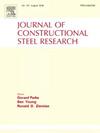Experimental behavior, hysteretic model, and finite-element analysis of a low-prestressed self-centering friction dissipative brace
IF 4
2区 工程技术
Q1 CONSTRUCTION & BUILDING TECHNOLOGY
引用次数: 0
Abstract
Traditional self-centering energy dissipative (SCED) braces require the initial prestressing force to exceed the damping force of the energy dissipation system for effective recentering, which limits their widespread application. To address this issue, a ratchet device that transfers only tension forces is connected in series with the energy dissipation system, significantly reducing the resistance during the recentering process and lowering the initial prestressing force required for self-centering. This paper proposed a novel low-prestressed self-centering friction energy dissipative (LP-SCFED) brace. The brace utilizes basalt fiber-reinforced polymer (BFRP) tendons to provide recentering capability and incorporates a friction device for energy dissipation. The mechanical properties of the brace were analyzed, and a hysteretic model for the brace was developed and validated. Quasi-static tests were conducted on seven 1/3-scaled specimens to investigate the effects of the initial prestressing force, the total area of BFRP tendons, and friction force on the seismic behavior of the brace. The results show that specimens with friction and prestressing devices exhibited a typical flag-shaped hysteresis curve, stable energy dissipation capacity, and good self-centering ability with the self-centering ratio exceeding 98 % at 2.0 % drift. The ratchet device eliminated the resistance of the friction device during unloading, allowing the brace to recenter with an initial prestressing force of only 3.2 % of the friction force. Besides, the self-centering behavior was insensitive to the initial prestressing force and the total area of the BFRP tendons. Under 3.0 % drift, all components remained elastic, and no damage occurred to the main structural elements. The finite element (FE) model agreed well with the test results, effectively reflecting the mechanical characteristics of the brace.
求助全文
约1分钟内获得全文
求助全文
来源期刊

Journal of Constructional Steel Research
工程技术-工程:土木
CiteScore
7.90
自引率
19.50%
发文量
550
审稿时长
46 days
期刊介绍:
The Journal of Constructional Steel Research provides an international forum for the presentation and discussion of the latest developments in structural steel research and their applications. It is aimed not only at researchers but also at those likely to be most affected by research results, i.e. designers and fabricators. Original papers of a high standard dealing with all aspects of steel research including theoretical and experimental research on elements, assemblages, connection and material properties are considered for publication.
 求助内容:
求助内容: 应助结果提醒方式:
应助结果提醒方式:


